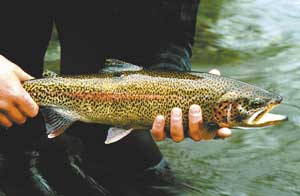
The fly-fisher who masters the art of nymph fishing will catch trout most anytime of the year, any time of the day, and in any kind of weather. The key word, though, is “master,” for it takes much practice and a load of patience to learn how to properly use a nymph. Many veteran anglers say it’s the most difficult form of trout fishing.
Since insect hatches usually are brief and sporadic in mountain streams, the vast majority of a trout’s daily diet (about 90 percent) is underwater insect life, insect life that crawls and walks along the bottom, burrows into sand and silt or drifts and tumbles with the current.
With few exceptions, nymphs are poor swimmers, so they’re practically helpless when swept downstream and are easy prey for trout.
When the adult insect gets ready to emerge, the nymph floats to the top, its back splits open, and the adult pops out. During this time, trout feeding patterns are noticeably different. Instead of rising to the surface and sucking in a floating insect, trout eat the nymphs just below the surface.
Look for flicking tails and bulging backs. Throwing a dry fly at trout feeding in this manner is an exercise in futility. However, if you float a nymph just below the surface through these feeding trout, you’ll get strike after strike.
In dry-fly fishing, the angler watches the surface of the water for signs of a trout rising to the fly, but in nymph fishing, the action takes place below the surface; thus, few visible clues are available when a trout gets ready to strike.
When a trout feeds below the surface, it sucks in food and water through its mouth, pushes the water through its gills where gill rakers strain out food and other material. The trout swallows whatever is digestible and spits out the rest. So anglers must learn to determine when the nymph is in the trout’s mouth and react quickly before the trout realizes the artificial nymph isn’t food and rejects it.
To provide an edge, the nymph fisher can use a strike indicator, usually a small ball of brightly colored foam or piece of yarn, tied to the leader.
If trout are in shallow water or feeding close to the surface, the strike indicator should be placed just above the tippet knot. If the feeding action is at the bottom, the indicator can be placed closer to the leader butt.
Watch for the strike indicator to pause or twitch then quickly set the hook. Expect to miss a bunch of trout until you get this part mastered.
Another technique is to put floatant paste on the leader 4 or 5 inches above the fly, which allows the nymph to float just below the surface, an effective technique for rising nymphs, but one that requires excellent eyesight. Watch the line for any kind of movement or pause and quickly set the hook.
Free-floating or unweighted nymphs are effective in shallow or slow-moving water. Beadhead nymphs work better when trout are feeding at or near the bottom or in swift water. For extra weight, add several small split shots along the leader. (Tie the split shot to the leader with an overhand knot to prevent the shot from flying off during casts).
Since you have to see what’s going on with the leader, short casts generally work best. The goal is to get a free-floating nymph. Cast upstream and let the nymph float to your target area, then slowly retrieve with occasional quick twitches. If the water is clear, watch for a sudden movement under the surface and be aware of any slight hesitation at the tip of the free-floating line.
“Dabbling” is another effective technique. Hold your rod high and let the nymph float down into the foamy water of a small plunge pool or waterfall.
This technique requires only a few feet of line, and anglers will be surprised at the number of strikes.
Most nymph fishers prefer light-weight rods, floating line and a 9-foot leader. The finer the tippet, the better — anything from 3X to 5X. A great deal of finesse is required for fine tippets.
If you spot a trout near the far side of a creek or river bank, let the nymph float to it by casting across and upstream of the target area. Then follow the drift of the nymph with the rod, keeping the tip up and mending line as the fly drifts. Give the fly an occasional twitch as it drifts and when it reaches the target.
If you don’t get a strike, move a few paces downstream, make a roll-cast and repeat the procedure.
For deep, still pools, make long casts and let the weighted nymph sink, occasionally twitching it as you retrieve. Anytime the line stops, quickly set the hook.
As with dry-fly fishing, use dark patterns in winter months. Some suggested patterns to always have in your fly box are the Hare’s Ear, Zug Bug, Blue-Winged Olive, Brown Stone, Coffey’s Stone, Stickbait, Pheasant Tail, Prince, Secret Weapon, and, if it’s around spawning time, egg patterns.
Learning how to use nymphs will require spending some time at a stream — more than likely some of it frustrating. The reward will be that once you master the technique, you’ll catch trout when everyone else is getting skunked.




Be the first to comment